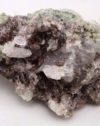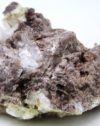HISTORY, NAME, LOCALITIES: Bornite, pronounced BORN-ite, was recognized as a mineral species in 1725 and named for the Austrian mineralogist Ignaz von Born. Bornite is collected in Austria, Morocco, Kazakhstan, England, South Africa, Australia, Peru, Chile, Zimbabwe, and the United States (Arizona, New Mexico, Nevada, Utah, Wisconsin, Montana).
MINERALOGY, PROPERTIES, OCCURRENCE: Bornite [copper iron sulfide, Cu5FeS4] crystallizes in the cubic system, usually in massive or compact forms; crystals are rare. It has a Mohs hardness of 3.0, no appreciable cleavage, an uneven-to-conchoidal fracture, and a substantial specific gravity of 4.9-5.1. Its copper-red to bronze-brown color is almost always masked by a bright, iridescent, blue-green-purple-gold tarnish that justifies its nickname of “peacock ore.” Bornite occasionally occurs in skarns and carbonatites, but it is most often found in massive hydrothermal replacement deposits in association with other copper-sulfide minerals.
METAPHYSICAL PROPERTIES, LORE, USES: Bornite is a minor ore of copper. According to metaphysical practitioners, bornite is a stone of joy, happiness, and healing that inspires hope, elevates moods, fights depression, and aids in identifying sources of negativity. Because of its bright iridescence, bornite is occasionally worn in pendants.
COLLECTORS’ INFORMATION: Bornite is widely collected for its bright, multicolored, iridescent tarnish and its association with other copper-sulfide minerals.





 Axinite #10
Axinite #10  Axinite #8
Axinite #8